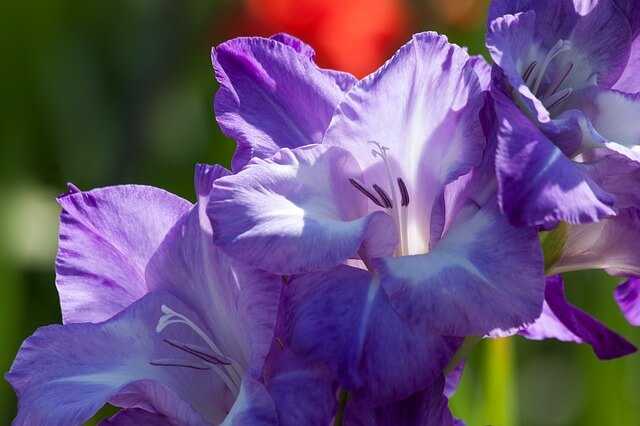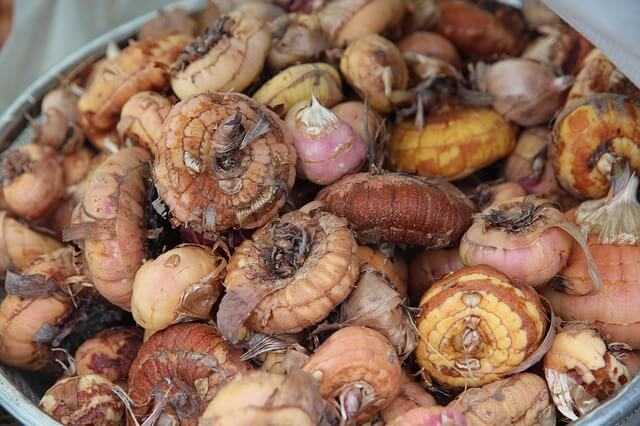Gladiolas, Gladiolus, or gladioli all are the same and these plants grow from large, firmed bulbs called corms. A scab is the major disease of these flowering plants. the Pseudomonas syringae bacterium and attacks the gladiolus corms which is caused scabs on gladiolus. If you have gladiolus plants with scab, you may want to learn more about this condition. Read more information about identifying, preventing, and controlling gladiolus scab. how to plant gladiolus bulbs

Scab On Gladiolus or gladiolas
How Do You Know If You Have Gladiolus or gladioli Plants With Scab? Initial symptoms are small dots on the lower leaves. These develop into round, water-soaked spots, which are initially light-yellow in color. Over time they turn black or brown. The scabs on the gladiolus have entered the second stage of the disease, when the shallow lesions appear sunken, with raised edges that have the appearance of a scab. These grow and multiply together, forming large areas of disease. Diseased spots release a sticky yellowish-brown substance. In the late stages, the scab causes the neck or base of the plants to rot. All gladiolus and gladiolas plants with scabs look ugly and sick and those most affected will die.
Controlling Gladiolus or gladioli Scab
To start controlling or preventing this kind of disease, you need to understand it. The bacteria will build up in the soil than on the corms over winter. They can live for up to two years in both locations, making the gladiolus scab more difficult to control. In some types of situations, scabs are more likely to form. For example, you will see more scabs on gladiola during the rainy season, when the soil is wet, and the weather is warm. Heavy use of nitrogen fertilizers also encourages bacteria to grow.
Gladiolus or gladiolas scab treatment
The best gladiolus or gladioli scab treatment involves monitoring and caring for the corms. Inspect the corms carefully before planting them. If they seem to be infected, don’t put them in your garden soil. Again Check the corms when you take them out of the soil for winter storage. Dry them thoroughly before storing them in a cool, ventilated place. Any injury to the corm makes your plant more likely to need gladiolus scab treatment. Look for corms bulb mites, grubs, and wireworms in the soil and deal with them if they appear. Use only sterilized pruning tools and only prune during dry weather to avoid spreading bacteria. Finally, rotate the gladiolus planting beds. Do not plant these flowers in one place for more than a few years in a row.

you can read this too
Benefits of Giloy ghanvati | Surprising 9 Benefits of Giloy Juice
How to plant gladiolus bulbs
Gladiolus does not bloom: Tips for flowering gladiolus plants
Gladiolus plants are beautiful spikes of color that adorn the landscape in summer. They are not very hardy in winter and many northern gardeners may feel frustrated that their gladiolus does not bloom after the cold season. If you’ve ever wondered why your glades don’t bloom, here are some answers to the various reasons why flowers don’t bloom on gladiolus. Because happiness has not blossomed
Gladiolus grow from bulbs, which are bulb-like underground storage organs. Glades grow in sunny humidity areas of the garden with good drainage and rich organic charge soil. Corms should be healthy and about 3 inches (2 cm) in diameter when planting in autumn. Gladiolus comes in a riot of colors and blooms again every year. Gardeners in the north need to pick autumn corms and store them in the cold season to protect the gladiolus from freezing temperatures. It is difficult to say the only reason why gladiolus does not flower. Here are the most common explanations:
Site Terms:
Site conditions are a great possibility. Corm may have experienced frostbite or may have been planted in flood-prone zones. When frozen, the coms crack and harden, and moist corms fungus and rot. If the area is overgrown or shaded by trees or hedges, gladiolus will not flower because the plant needs full sun to bloom. In addition, the planting space can become too narrow over time so that the thin stalks and leaves cannot come out. Picking up and re-cultivating the soil every year will ensure that this does not happen.
Age:
Gladiolus corms expand and grow over time, but the original corms eventually cost. The number of years before this happens may vary but usually new corms will take a sluggishness.
Fertilizer:
Newly planted coms also cannot bloom because the coms are too small. Wait a year and fertilize with a balanced diet of 8-8-8 plants in the spring to encourage foliage and flower formation. make sure to have annual fruits on gladiolus plant to bloom but avoid any food with a high percentage of nitrogen, which helps in foliar formation. If your glades are not in bloom and close to the lawn, they may not produce blooms due to the high nitrogen content of the lawn fertilizer. Adding high phosphorus fertilizer or bone meal around your plants can help reduce this.
Insects:
Gladiolus infested by a small insect called thrips will not flower. Due to the feeding action of this “no seam” bug, the flowers wither before they are fully formed and fall off the tree. There are many pesticides that you can use to kill nasty little insects like neem oil or try gardening soap. In some areas, rats, squirrels, fields, and moles may be responsible for gladiolus not as expected blooming. These animals may like corms and cuddle on them, creating a situation where “glades do not bloom”.
Illness:
Rot is the most likely culprit for the disease due to the lack of flowers on the gladiolus. Corms are susceptible to root blight, bacterial scab, as well as many viruses. Always keep dry in a dry place and choose healthy and spotless corms.